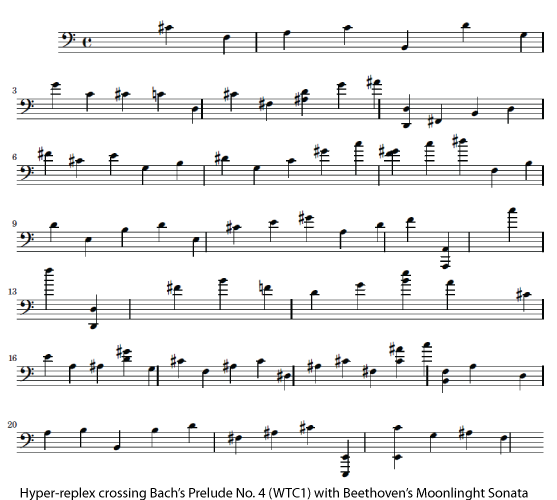| R E P L E X M U S I C |
| Chris Thornton, University of Sussex |

|

|
| uncertainization | replexes | markov cascades |
| Given some symbolic data (such as a sequence of note values) we can take any one construct and replace it with a choice that includes that construct. `Uncertainizing' the data in this way produces a loss of information and this can be measured precisely: it is just the entropy of the (distribution underlying) the choice. But uncertainization may also have the effect of eliminating some symbols, reducing the total number of symbols in use and producing an increase of mean information per symbol. The uncertainization producing highest mean symbol information is then the optimal informational refinement of the data. Deriving optimal refinements in a recursive way (i.e., obtaining refinements of refinements) then produces a tree-structured model in which choices play the role of disjunctive symbols. | Once we have a refinement model for some symbolic data, we can then use top-down symbol expansion to produce variations of the original data. If the original data specified a musical sequence of some sort, what is obtained is a variation of that sequence. Variations derived in this way are termed `replexes'. X is a `replex' of Y if it is derived (by top-down expansion) from a valid refinement model for Y. As a variation on the theme, we can combine refinement models for several datasets. The variation that is then obtained (using top-down expansion) is a `hyper-replex': X is a hyper-replex of Z and Y, if it is derived by top-down expansion from a combination of refinement models of Z and Y. | When a replex is generated using top-down symbol expansion, there is the question of how to select from a particular choice (i.e., how to `expand' a disjunctive symbol). This can be done at random or it can be done in a way that takes the distribution underlying the choice into account. There is also the possibility to learn a Markov model for each refinement level in the model. In resolving a particular choice, we can then apply the Markov model formed for the relevant level, taking into account any data already generated. In this way, the Markov models can have the effect of `tuning' the generated variation. All the musical examples on this page were generated using this type of `Markov cascade.' |
The Play buttons in the grid access musical replexes. These were derived from original compositions (in the form of MIDI files), re-represented as sequences by using an offset representation for notes. The derived replexes were then put back into a musical form for playback. All of the pieces are extracts.
The Play buttons in this grid access `hyper-replexes'. These were derived from amalgamated information structures, i.e., structures derived from more than one source. Mainly, the information structures used originate in musical sources. But in a couple of cases, they originate in music and text.
|
Extract from hyper-replex crossing
Bach's Prelude No. 4 (WTC1) with Beethoven's Moonlight Sonata. (Score opposite.)
|

|
|
Extract from hyper-replex crossing Bach's Prelude No. 3 from WTC1 with
Philip Glass's Similar Motion.
| |
|
Extract from hyper-replex crossing
the final paragraphs of Barack Obama's inaugural speech
and bars 127-174 of Brahms's Rhapsodie.
| |
|
Extract from hyper-replex crossing
Ch. 2 of Dickens' Hard Times with Scarlatti's Sontata in
D (K.5) and Bach's Cantata `Jesu Joy of Man's Desiring'
| |
|
Extract from hyper-replex
crossing some text from Jon McCormack on
generative systems (relating to the third `Iteration' conference), some
cricketing scores reported by Mark D'Inverno for 2008, the paragraph of
text from `The Creative Mind' containing Maggie Boden's definition of
radical originality, and part of Mozart's Recitative and Aria for Soprano
(written for Aloysia Weber in Mannheim), K 316 `Popoli di Tessaglia'. In
tentative celebration of the 2008 Dagstuhl seminar on Computational Creativity.
|
To generate a replex of the source, press the Make button. A new instance will then be constructed and displayed in the bottom-left window.
You can also download the jar file and run the applet as an application.